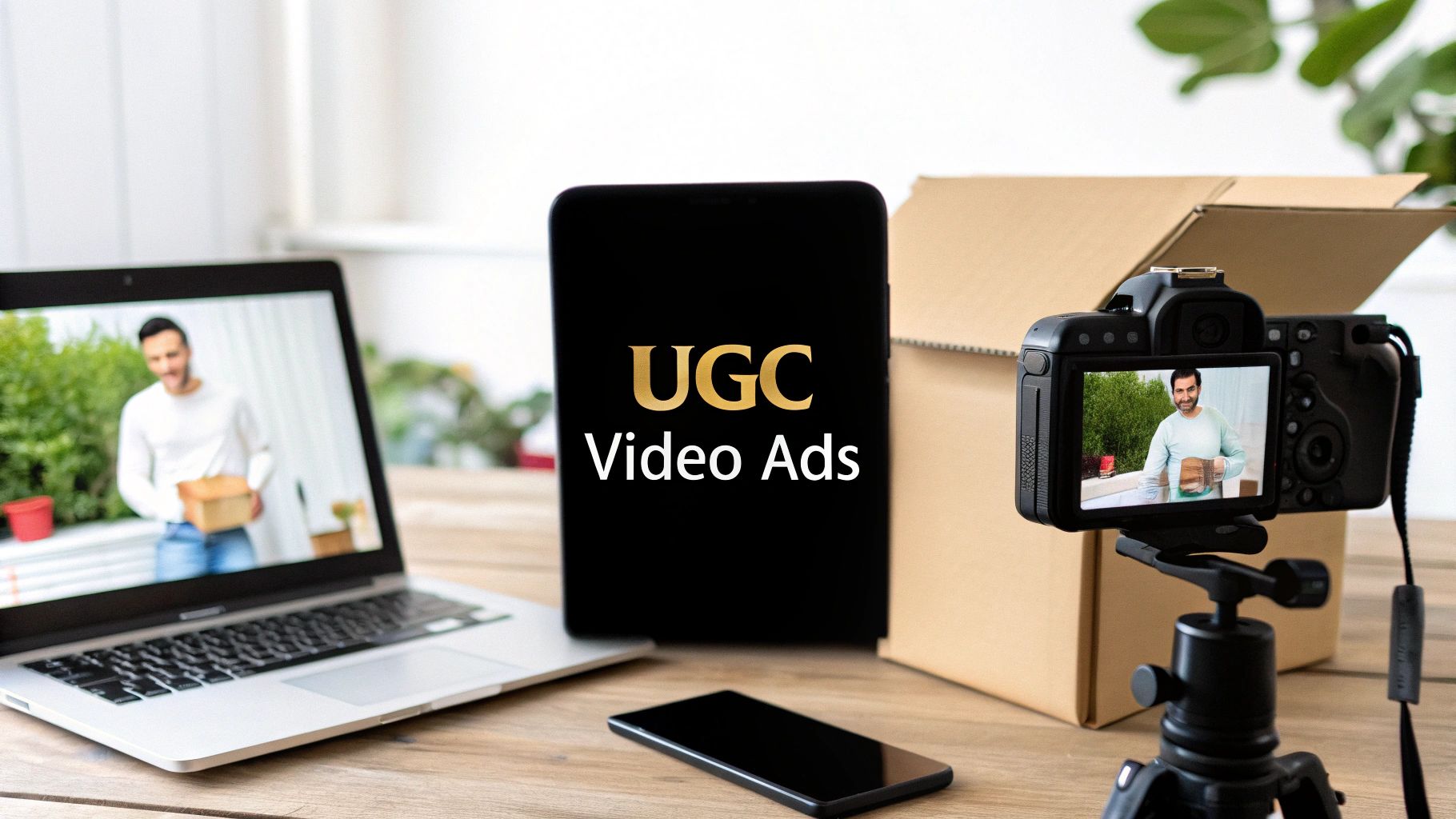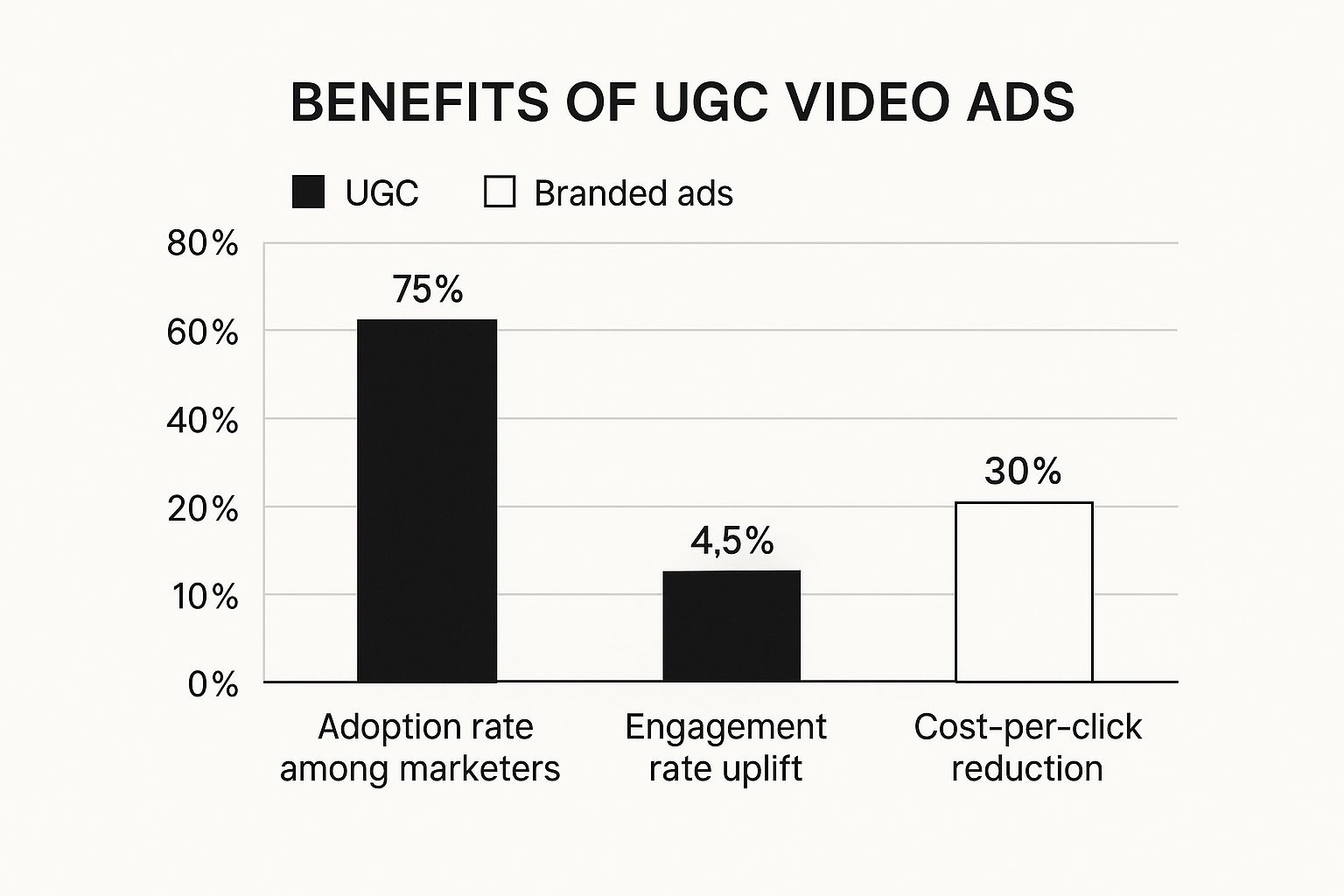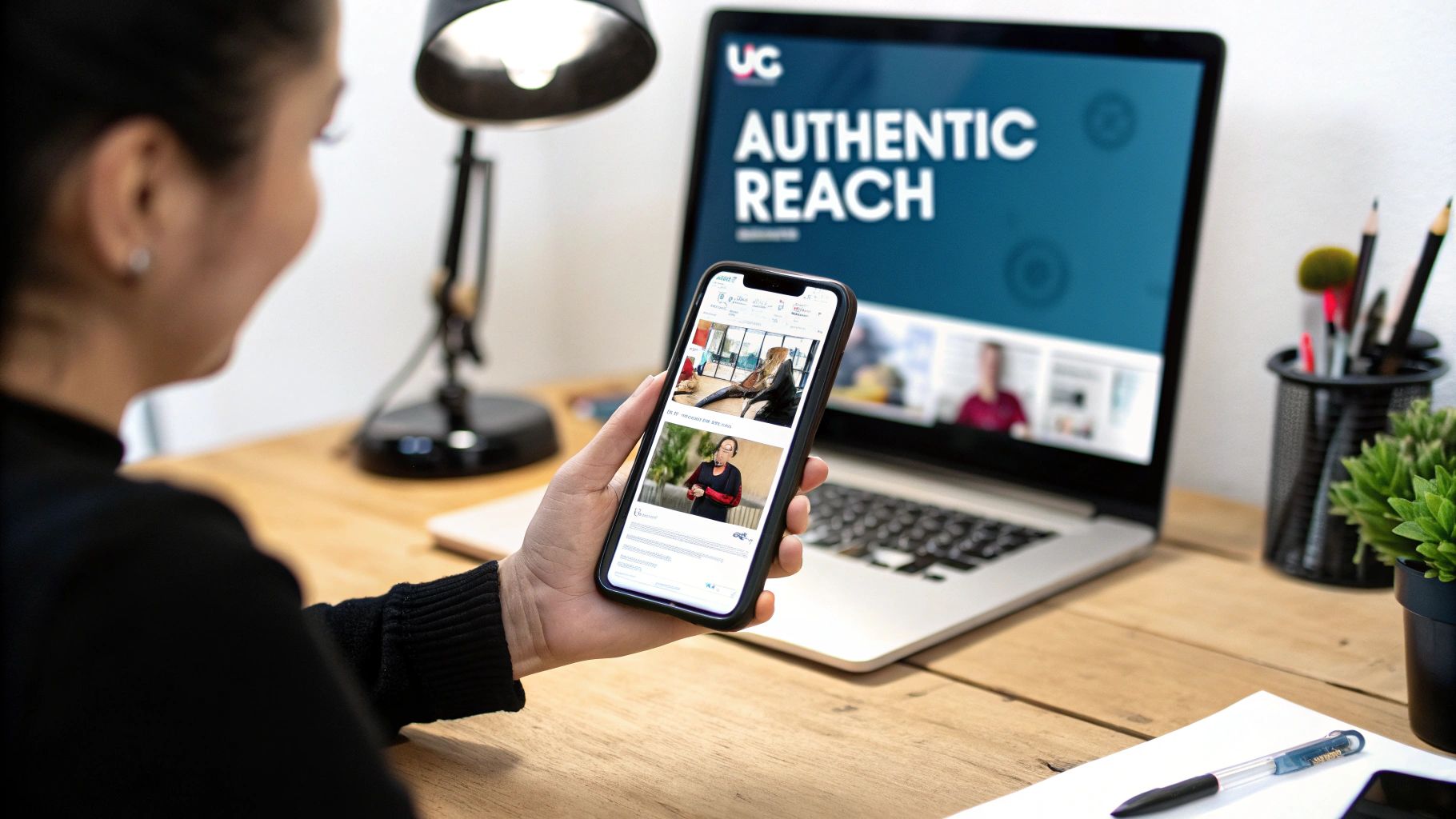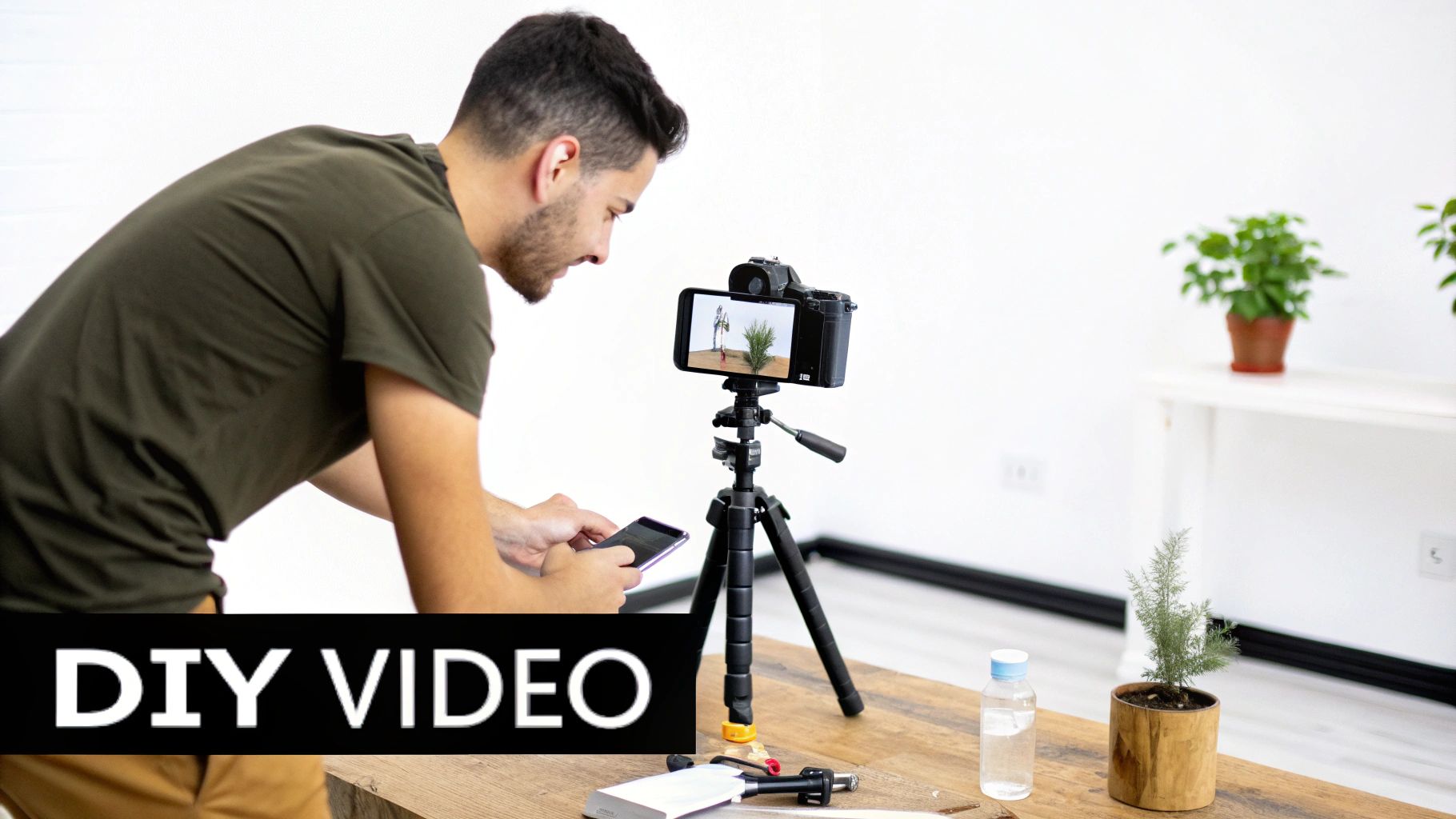
Your Guide to Winning with UGC Video Ads
Discover how to leverage UGC video ads for authentic marketing. Our guide covers sourcing content, launching campaigns, and driving real conversions.
So, what exactly are UGC video ads, and why are they suddenly everywhere?
At its core, a UGC video ad takes content made by real, everyday customers and turns it into a paid advertisement. It’s the opposite of a slick, polished commercial shot in a studio.
What Are UGC Video Ads And Why Do They Work?
Think about your own social media habits for a second. You’re scrolling your feed, and a glossy, overproduced ad pops up. You probably swipe right past it without a second thought.
But then, you see a video from someone who looks just like you. They’re unboxing a product they just bought, genuinely excited, and showing you exactly how it solved a problem they were having. That’s a UGC video ad in action.
UGC simply stands for User-Generated Content. Instead of hiring actors and writing scripts, brands are now tapping into the authentic enthusiasm of their actual customers, fans, and creators. They're repurposing those genuine moments for their ad campaigns, and it’s working incredibly well.
The Psychology of Authenticity
The secret sauce behind UGC’s success is a simple, fundamental human truth: we trust people more than we trust brands.
Traditional ads often feel impersonal and pushy, which immediately puts our guard up. UGC, on the other hand, tears down that wall by delivering powerful social proof. When we see real people—not paid actors—endorsing a product, it feels less like an ad and more like a trusted recommendation from a friend.
This authenticity taps into some powerful psychological triggers:
- It Builds Instant Trust: It’s a fact that consumers are 92% more likely to trust recommendations from their peers than from a brand itself. UGC delivers that peer-to-peer trust on a massive scale.
- It’s Instantly Relatable: The content is often raw, unpolished, and feels like it was shot on a phone in someone’s living room. This makes it far more relatable than a picture-perfect studio production.
- It Cuts Through Ad Fatigue: UGC videos look and feel like the organic content we see from friends and creators we follow. They blend right into social feeds, grabbing our attention without screaming, "I'm an ad!"
This visual breaks down just how much better UGC video ads perform compared to their traditional, brand-created counterparts.

The numbers don't lie. Marketers are flocking to UGC because it drives better engagement at a lower cost. If you want to dig deeper into the power of this trend, there are plenty of proven ways to boost social media engagement, including UGC campaigns.
Traditional Ads vs UGC Video Ads at a Glance
To really see the difference, it helps to put them side-by-side. Here's a quick breakdown of how UGC stacks up against the old way of doing things.
| Attribute | Traditional Video Ads | UGC Video Ads | | :--- | :--- | :--- | | Creator | Brands, agencies, actors | Real customers, fans, creators | | Tone | Polished, scripted, "salesy" | Authentic, raw, conversational | | Trust Factor | Low; often viewed with skepticism | High; seen as a peer recommendation | | Production | High-cost, long timelines | Low-cost, fast turnaround | | Performance | Declining engagement, high ad fatigue | Higher engagement, lower cost-per-click | | Goal | Sell a product | Share an experience, build community |
As you can see, the two approaches are worlds apart. One broadcasts a message at an audience, while the other starts a conversation with them.
A Fundamental Shift in Marketing
Make no mistake, this move toward UGC isn't just a fleeting trend. It's a major strategic shift in response to how people buy things today.
The User-Generated Content market itself has ballooned to over $7.6 billion, which is a staggering 69% increase from the previous year. And with experts projecting a compound annual growth rate of nearly 29%, it’s clear that authentic, customer-first content is the future of advertising.
In a world drowning in ads, authenticity has become the most valuable currency. UGC video ads allow brands to talk with their audience, not just at them. This shift helps build a real community around a product, turning happy customers into your most passionate advocates. It’s a powerful cycle of trust and growth that a polished ad simply can't buy.
The Business Case for UGC Video Advertising

Jumping on the UGC video ad bandwagon isn't just about chasing the latest marketing trend. It’s a smart business move with real, measurable returns. The magic is in how these raw, authentic videos connect with people at the most critical moments of their buying journey.
Think of it as powerful social proof in action. When someone on the fence sees a real person—not an actor—genuinely loving a product, it melts away their skepticism. This isn't just a hunch; the data backs it up. A solid 79% of consumers say UGC plays a huge role in their decision to buy something.
This is exactly why the global User-Generated Content market is projected to skyrocket from roughly $6.7 billion to a massive $132.73 billion by 2034. This isn't just growth; it's a fundamental shift in how brands build trust and connect with people. You can dig into more of the numbers behind this expansion in the full market analysis on market.us.
Maximizing ROI and Minimizing Costs
One of the best things about UGC is how friendly it is on the wallet. A single, professionally shot brand commercial can set you back anywhere from $1,200 to $50,000. That involves pricey equipment, actors, and a whole production crew—a budget that's simply not realistic for many businesses.
Now, compare that to a great UGC video. You can often get one for as little as $50 to $200. This massive drop in upfront cost means you can create way more ad variations. More ads mean more A/B testing, more optimization, and better results, all without draining your marketing budget.
By trading high production costs for high authenticity, brands can seriously boost their return on ad spend (ROAS). UGC ads typically see 4x higher click-through rates and can cut your cost-per-click by 50% compared to slick, traditional ads.
Building a Community of Brand Advocates
Beyond the immediate sales boost, UGC video ads are a long-term play for building a loyal community. When you feature a customer’s video, you're not just running an ad. You're giving a shout-out to a real person, celebrating them as part of your brand's story.
This simple act turns happy customers into passionate brand advocates. These are the people who will:
- Spread the word for free: They’ll tell their friends and family about you, creating authentic word-of-mouth buzz.
- Have your back: When a negative comment pops up, these loyal fans are often the first to jump in and defend you.
- Give you priceless feedback: An engaged community is an incredible source of honest insights that can help you make your products even better.
This approach builds a powerful, self-sustaining cycle of trust and loyalty. Every UGC ad you run doesn't just push for a sale—it deepens the connection with your customers, creating a competitive edge that money alone can't buy.
How to Source High-Impact UGC Videos

Great UGC doesn't just fall into your lap—you have to go out and get it. If you want a steady pipeline of authentic content, you need a proactive strategy that encourages your happiest customers and talented creators to share their experiences.
The easiest way? Just ask.
You can set up automated post-purchase emails or texts inviting customers to share a quick video of their unboxing moment or product review. Tossing in a small incentive, like a discount on their next order, is a simple way to supercharge your submission rates.
Another fantastic approach is to run a contest or a branded hashtag campaign on TikTok and Instagram. This not only floods you with fresh content but also generates organic buzz and builds a real community around your brand. For a deeper dive, there are great guides on how to turn customers into UGC creators that break down how to build these relationships from the ground up.
Working With Creator Marketplaces
While getting videos straight from your customers is the gold standard, sometimes you need specific content, and you need it now. This is where UGC creator marketplaces are an absolute lifesaver. These platforms connect you directly with experienced creators who know exactly how to produce authentic, ad-ready videos on demand.
When you use a marketplace, your creative brief is everything. A good brief should:
- Define the Goal: Is this for a TikTok ad? An Instagram Reel? Tell the creator what you need the video to accomplish.
- Share Key Talking Points: Give them the must-have features and benefits, but don't give them a script. Let them talk like a real person.
- Grant Creative Freedom: The magic of UGC comes from the creator's unique voice and style. Encourage them to be themselves.
A winning UGC video is all about authenticity, not perfection. Clear audio and a relatable delivery will always outperform slick, professional editing. The second a video feels too polished is the second it stops feeling like real UGC.
What to Look for in a Winning Video
As the content starts rolling in, you need to know how to spot the winners. The best UGC videos aren't about fancy camera work; they're about connection and clarity.
Look for videos that grab your attention within the first three seconds, tell a relatable story, and show off the product in a natural, believable way.
Of course, sourcing the raw footage is just the first step. Turning that content into a high-performing ad is a whole other skill. For a closer look at that part of the process, check out our guide on how to create a video ad that actually converts.
Alright, you've got a killer collection of authentic user videos. That’s a huge win, but the real fun starts now: turning that raw gold into a high-performing ad campaign. This isn't just about uploading a clip and hitting "publish." It’s a hands-on cycle of testing, learning, and refining to figure out what actually gets your audience to click.
Before you do anything else, you absolutely must secure proper usage rights. This is non-negotiable. Before a single video goes live as an ad, you need explicit, written permission from the creator to use their content for paid advertising. A quick DM won't cut it. A formal agreement or media release protects both you and the creator, ensuring your entire campaign is built on solid legal ground.
With your content officially cleared for takeoff, it's time to adapt it for the ad world. Raw UGC often needs a little polish to stop the scroll. Think about adding bold captions or subtitles—since over 80% of Facebook ads are watched on mute—and writing a headline that grabs attention immediately.
A/B Testing Your Way to Success
Never assume you know which ad will be a winner. The only way to maximize your return is through relentless A/B testing. By isolating one element at a time, you can truly understand what drives performance.
- Test Different Hooks: The first three seconds are everything. Pit a question hook ("Struggling with dry skin?") against a benefit-driven one ("Here's how I finally got glowing skin.").
- Vary the UGC Clips: Run a product demo video against a heartfelt testimonial. Does your audience need to see how it works, or do they care more about why someone loves it?
- Experiment with CTAs: See if a direct "Shop Now" converts better than a softer "Learn More." You'd be surprised how much a simple change in your call-to-action can impact click-through rates.
This constant testing is more important than ever. With social media video ad spend expected to rocket past $60.94 billion, the space is getting crowded. In fact, 67% of consumers say they want more variety in brand storytelling to fight off ad fatigue. A deep library of diverse UGC video ads is your best weapon for keeping campaigns fresh and effective. You can dive deeper into these video ad trends at iab.com.
Measuring What Truly Matters
It’s easy to get distracted by vanity metrics like likes and shares. But successful campaigns are built on numbers that directly impact your bottom line.
True optimization isn't about chasing viral fame; it's about driving profitable growth. Focus your analysis on the key performance indicators (KPIs) that connect your ad spend directly to business results.
Instead of obsessing over view counts, laser-focus on metrics like these:
- Return on Ad Spend (ROAS): For every dollar you put in, how many are you getting back? This is the ultimate test of profitability.
- Conversion Lift: Is your ad campaign actually generating more sales than you would have gotten without it?
- Cost Per Acquisition (CPA): How much does it cost, on average, to get a new customer from this specific UGC ad?
By constantly tracking these core KPIs, you can systematically improve your UGC video ads. You’ll turn authentic customer content into a predictable and powerful engine for growing your business.
Winning UGC Video Ad Examples Decoded
 Theory can only take you so far. To really get why UGC video ads work so well, you need to see them in the wild. Let’s break down what makes these campaigns click by looking at some real-world examples from brands that have absolutely nailed the art of authenticity.
Theory can only take you so far. To really get why UGC video ads work so well, you need to see them in the wild. Let’s break down what makes these campaigns click by looking at some real-world examples from brands that have absolutely nailed the art of authenticity.
These aren't just commercials; they're genuine stories from real people. By digging into what makes them successful, you can pull together some great inspiration and a practical game plan for your own strategy. You can also explore even more fantastic UGC video examples to see how other brands are getting in on the action.
The Beauty Brand Built on Authenticity
Glossier is the perfect case study. They grew into a $1.2 billion brand by leaning almost entirely on content from their customers. Their whole approach is a masterclass in building a brand from the ground up with raw, unfiltered proof.
Instead of glossy studio shots, their social feeds are packed with real people in their own bathrooms, sharing their skincare routines and makeup looks. This simple move makes their products feel relatable and trustworthy, turning one-time buyers into a fiercely loyal community.
The lesson from Glossier is crystal clear: letting your customers tell your story is far more compelling than any polished corporate message. It creates a cult-like following because people inherently trust what they see from their peers.
The Tech Brand Proving Its Power
Apple's #ShotOniPhone campaign is legendary for a reason. It’s a brilliant way to use UGC to demonstrate product quality without saying a word. By plastering billboards and social media with breathtaking photos and videos from everyday users, Apple doesn't just tell you its camera is amazing—it proves it.
The campaign pulled in over 6.5 billion impressions, and the secret to its success is that the content is both inspiring and attainable. It showcases the incredible power of a device that millions of people already have in their pockets, encouraging them to get creative and share their own work.
The Subscription Box That Knows Its Audience
BarkBox, the subscription service for dog toys and treats, has built an entire brand on the back of adorable and chaotic UGC. Their most effective ads often feature dogs going absolutely wild with joy as they unbox their monthly delivery.
Why does this work so well? Because it plugs directly into the emotions of their target audience: dog people.
- It forges an instant emotional bond: Let's be honest, who doesn't love watching a happy dog?
- It showcases the product experience: You don't just see the toys; you see the sheer delight the box delivers.
- It builds incredible brand loyalty: Featuring customers' pets makes them feel like they're part of a fun, exclusive club.
Each of these examples gets to the heart of what makes UGC video ads so effective. They win by choosing genuine connection over corporate perfection, every single time.
Common UGC Strategy Mistakes to Avoid
A great UGC strategy can feel like a superpower, but it's surprisingly easy to get it wrong. A few common missteps can completely torpedo the authenticity you're trying to build, turning a powerful asset into a waste of ad spend.
Let's walk through the pitfalls I see brands fall into all the time.
One of the biggest temptations is to over-edit the content. You get a great video from a creator, and the instinct is to polish it. You add slick graphics, professional color grading, and suddenly… it looks just like another corporate ad. You've scrubbed away the exact thing that made it special: its raw, relatable, human feel.
Another massive mistake is failing to secure clear usage rights. Finding a fantastic video on social media and just dropping it into your ad campaign is a recipe for a legal nightmare. You absolutely must get explicit, written permission from every single creator before using their content commercially. It’s non-negotiable and protects both your brand and the creator.
Ignoring Platform-Specific Needs
Posting the same exact video everywhere is a classic rookie error. That killer nine-second vertical clip that popped off on TikTok? It's going to die a slow, painful death as a pre-roll ad on YouTube. Every platform has its own culture, its own formats, and its own audience expectations.
Simply put, a one-size-fits-all approach just doesn't work. You're essentially lighting your ad budget on fire. Smart campaigns adapt the content to feel native to each platform, whether that's TikTok, Instagram Reels, or a Facebook feed.
Beyond those big ones, a few other common blunders can trip you up:
- Creating overly restrictive briefs: Handing a creator a word-for-word script suffocates their creativity. The magic happens when you give them key talking points and then get out of the way. Let them be authentic.
- Ignoring negative feedback: Every brand gets negative comments. The mistake isn't the feedback itself—it's deleting it or getting defensive. Address criticism head-on and show your community you're actually listening.
- Focusing only on viral content: Chasing a viral hit is like trying to bottle lightning. A steady stream of reliable, relatable videos from a diverse group of creators will almost always outperform the rare, unpredictable viral moment. Consistency beats lottery tickets.
Avoiding these mistakes is half the battle. If you're just starting to build out your UGC plan, our guide on how to create UGC content is the perfect place to lay a strong foundation and get started on the right foot.
Got Questions About UGC Video Ads? We've Got Answers.
Jumping into user-generated content for the first time? It's normal to have a few questions. Getting clear on the details is the best way to build a strategy that actually gets results.
Let's clear up some of the most common ones.
How Much Should I Expect To Pay For a UGC Video?
There’s no single price tag here, and honestly, that’s a good thing. The cost can be anything from completely free (when a happy customer posts a rave review on their own) all the way up to a few hundred bucks for a solid video from an experienced creator.
As a general rule of thumb, a high-quality video from a vetted creator usually lands somewhere between $150 and $350. The final price tag really depends on their experience, how complex the video is, and what kind of usage rights you need. Either way, it’s almost always a fraction of the cost of a traditional, high-production video shoot.
What Is The Difference Between UGC And Influencer Marketing?
This is a big one, and it's easy to see why they get confused. While they can look similar on the surface, their core purpose is totally different. Influencer marketing often uses creators with massive followings to get as many eyes as possible on a product, and the content can feel a bit more polished or aspirational.
On the other hand, UGC is all about authenticity and relatability. It’s the kind of content that comes from everyday customers or micro-creators, and its entire job is to build trust and social proof. An influencer post feels like an endorsement; a great UGC video feels like a genuine recommendation from a friend you trust.
Do I Need To Disclose That a UGC Video Is An Ad?
Yes. 100%. This is non-negotiable.
If you are paying a creator for their video or putting money behind it to run as a paid ad, you are legally required to disclose it. This usually means including a clear hashtag like #Ad or using the social media platform’s built-in branded content tools.
Think about it: the whole reason UGC works is because it’s built on trust. Being shady about a paid partnership not only puts you on the wrong side of advertising regulations, but it completely destroys the credibility you were trying to build in the first place.
Ready to create high-converting UGC video ads in minutes? ViewPrinter combines powerful AI avatars with viral hooks and product demos, letting you generate engaging content faster than ever. Start building your next winning ad campaign with ViewPrinter today!